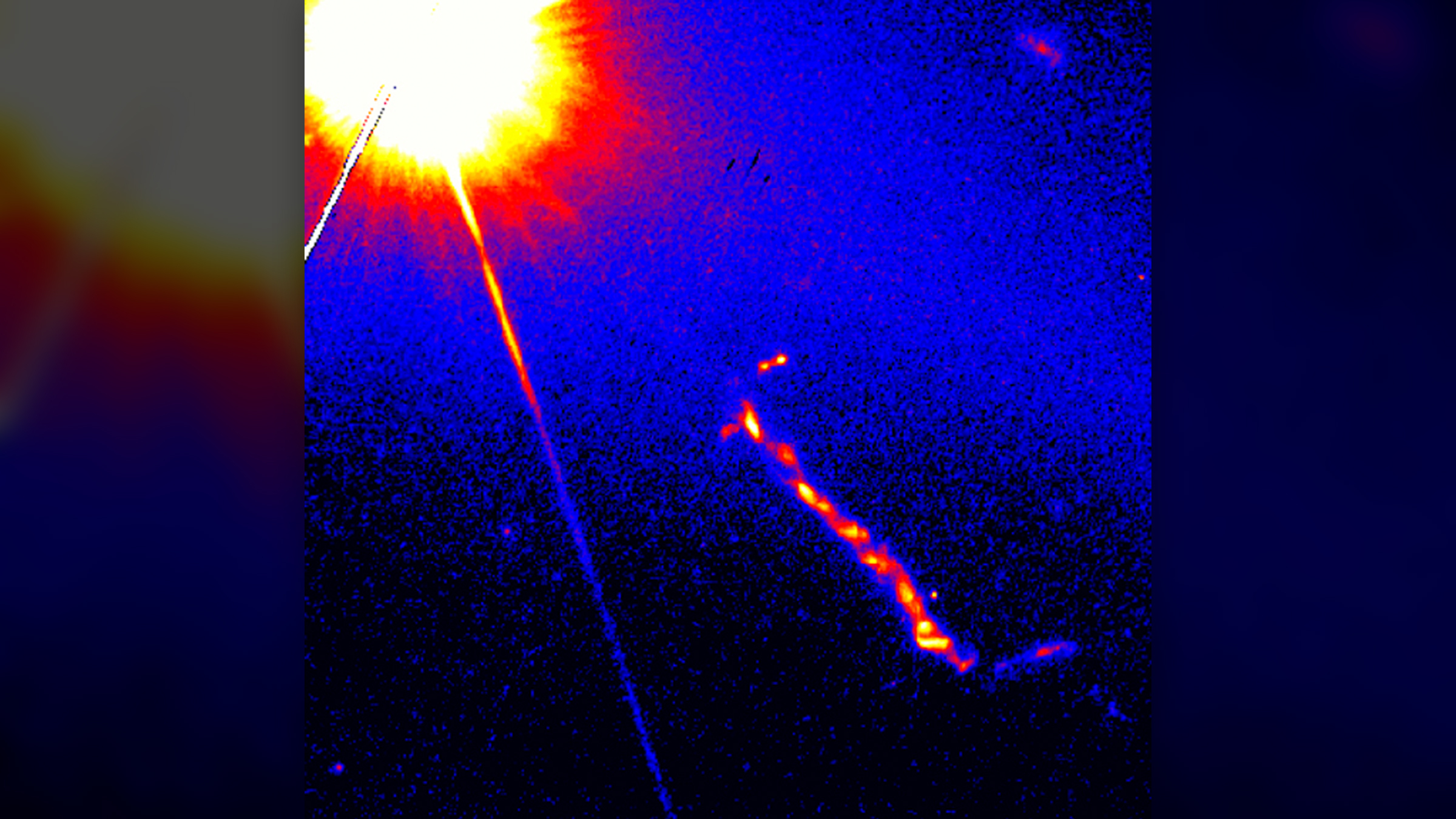What is the hottest place in the universe?
The hottest spot in the universe may well be near the edges of a supermassive black hole.

While the sun is the most scorching object in our solar system, its temperatures pale in comparison to several other cosmic bodies. So what is the hottest place in the universe?
"I think a good answer is very near a supermassive black hole, especially a supermassive black hole that's accreting, which just means it's eating gas," Daniel Palumbo, a postdoctoral fellow at the Black Hole Initiative, a research group at Harvard University, told Live Science. Feeding black holes that host relativistic jets — or enormous beams of material being propelled to "very near the speed of light" — are particularly sweltering, he added.
So far, the hottest place in the universe on record is the quasar 3C273, a brightly-shining region around a supermassive black hole roughly 2.4 billion light-years from Earth, Palumbo said. This region has a core temperature of about 10 trillion kelvin (more than 10 trillion degrees Fahrenheit and Celsius), according to the Greenbank Observatory in West Virginia. However, there is still uncertainty surrounding this temperature estimation, Palumbo added.
Supermassive black holes are extremely powerful and sit at the hearts of most, if not all, galaxies. As their name suggests, they are, well, super massive: Sagittarius A*, the supermassive black hole at the center of our Milky Way galaxy, has a mass millions of times greater than that of the sun. Like any black hole, quasar 3C273 has a gravitational pull that is so strong that nothing, not even light, can escape its grip.
Related: What is the coldest place in the solar system?
While this gravity sink is frigid on the inside, the ring of gas swirling around it — known as an accretion disk — is the opposite. As molecules are sucked into the black hole at high speeds, the friction produced by the collisions between this matter can let off temperatures of trillions of degrees Celsius. To put that into perspective, the sun's surface is 10,000 degrees Fahrenheit (5,500 degrees Celsius). These temperatures only increase when the black hole’s intense magnetic field whips some of that nearby matter into relativistic jets that can shoot out into space for millions of light-years, Palumbo added.
But the answer to where the single hottest place in the universe is may also depend on when you ask the question, according to Koushik Chatterjee, a fellow at the Black Hole Initiative. While he agrees that black holes are likely the steadily hottest spots, anywhere "there are cataclysmic events; that's where the hottest place would be," he said.
Get the world’s most fascinating discoveries delivered straight to your inbox.
When two big celestial bodies collide, the resulting explosion can produce extremely high temperatures. For example, two neutron stars — the collapsed cores of massive stars — crashing into each other can produce a temperature of 1.5 trillion F (800 billion C), according to a 2019 study published in the journal Nature Physics. A black hole colliding with a neutron star could also emit incredibly high temperatures, Chatterjee said. But like a flash in a pan, these cosmic collisions are often fleeting.
It's also difficult to pin down the single hottest place in the universe because "it's tricky to study the temperatures of very distant objects; you can't just measure it with a thermometer," Palumbo said, and there is still a lot of uncertainty surrounding the precise temperatures of black holes.
Instead, scientists measure the energy emanating from supermassive black holes, which can emit bright beams of light, radio waves and X-rays. Researchers can estimate temperature based on models that factor in the wavelengths of electromagnetic radiation produced by these sources.
"We let the light from … very distant objects come to our telescopes," Richard Kelley, a senior scientist of solar studies at NASA, told Live Science. "That light goes down and goes into a sensor that can measure the energy or the wavelength of the radiation, we build up a spectrum, and then by analyzing the spectrum we can infer temperature."
A future X-ray observatory called the X-ray Imaging and Spectroscopy Mission (XRISM) will help scientists more accurately measure high-temperature gases in space, Kelley said. As more advanced tools continue to be developed, scientists may find areas that are even hotter than quasar 3C273.
"I think what would be very fair to say is that as it stands, the tools we have for understanding the temperatures of material around supermassive black holes are limited but rapidly evolving," Palumbo said.

Kiley Price is a former Live Science staff writer based in New York City. Her work has appeared in National Geographic, Slate, Mongabay and more. She holds a bachelor's degree from Wake Forest University, where she studied biology and journalism, and has a master's degree from New York University's Science, Health and Environmental Reporting Program.
 Live Science Plus
Live Science Plus






